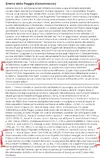Hi All, following the great last post of Little Doctor I remember well when I had the chance to get in Villa Huygens looking for some esoteric evidence related to this incredible story that intrigues me more and more.
Descrivere in italiano questa esperienza mi riporta ancor più vividamente ai quei momenti quando dopo aver percorso il lungo ed ombroso viale alberato della Villa mi sono ritrovato a passeggiare sull'erba di un grande giardino in uno schianto di sole che, dopo l'ombra persistente concessa dal fresco viale lasciatomi alle spalle, abbagliava ogni cosa costringendo a socchiudere gli occhi.
La Villa si trova al di là del prato e domina tutto il parco con austera imponenza. Le sue mura spiccano ergendosi dall'erba tagliata che la fa sembrare poggiata su di un tappeto verde. Un' eccezionale veduta per chiunque abbia la fortuna di accedervi.
Cercai un ingresso per entrare nell'edificio. La porta principale era semichiusa. Sicuramente forzata da qualche curioso. Iniziai con cautela a muovermi all'interno dei locali in un fresco ristoratore ed un silenzio quasi irreale grazie alle spesse mura antiche del nobile edificio.
Ripensando agli scritti di LD avevo l'aspettativa di trovare qualche cosa di importante. Improvvisamente alzando lo sguardo in alto, ero salito al piano superiore, fui attirato da un ornamento che abbelliva in alto le pareti di una stanza che capii subito trattarsi della "Stanza delle Spirali". Quindi essa esiste veramente. Scattai immediatamente una foto. Mi ritenni fortunato. Continuai la perlustrazione, ma la mia aspettativa era stata ben ripagata.
Uscito e ritrovatomi sul prato, dando le spalle all'edificio, notai alla mia sinistra la Cappella di Santa Lucia che era in fase di ristrutturazione. Altra foto da conservare.
Mi incamminai verso lo scuro viale che è come un fuso perfetto incastonato tra due estesi giardini. Alla mia destra il Giardino di Vita ed alla sinistra il Giardino di Pietra che era stato ripulito dalla vegetazione che al contrario assai pertinace avvolgeva e nascondeva ancora alla vista l'altro giardino, quello di Vita.
Arrivai oltre il prato. Mi avvicinai al Giardino di Pietra e mi addentrai un poco. Sentivo però come un fruscio provenire dal fondo ed avvicinandomi agli alberi che si trovavano alla fine di esso quel rumore pareva più un lamento sommesso o una supplica lontana.
Mi accorsi che tra i rami di un grande albero spuntava a momenti come un volto che mi fece sobbalzare, ma scattai un'altra foto per studiarla poi con calma successivamente. Non andai oltre. Non mi sentii sicuro in quel frangente. A mio avviso si trattava di una sorta di entità come imprigionata nella corteccia di quel grande albero, sicuramente secolare. Ma di quale essere poteva trattarsi: Huygens o Suor Margherita Boero magari, oppure chissà chi altro. Ricordo bene l'episodio a Pantelleria dove il Caporale, era il 1983, si ritrovò dinanzi Leontino il Giovine proprio con le medesime modalità di manifestazione paranormale.
Here are the photoes I taken on that particular day.
TOURIST
ENGLISH
Describing this experience in Italian brings me even more vividly to those moments when after walking along the long and shady tree-lined avenue of the Villa I found myself walking on the grass of a large garden in a blaze of sun that, after the persistent shade granted by the cool avenue left behind me, dazzled everything forcing me to half-close my eyes.
The Villa is located beyond the lawn and dominates the entire park with austere grandeur. Its walls stand out rising from the cut grass that makes it seem to rest on a green carpet. An exceptional view for anyone lucky enough to access it.
I looked for an entrance to enter the building. The main door was half-closed. Surely forced by some curious person. I began to move cautiously inside the premises in a cool restaurant and an almost unreal silence thanks to the thick ancient walls of the noble building.
Thinking back to LD's writings I had the expectation of finding something important. Suddenly looking up, I had gone up to the upper floor, I was attracted by an ornament that embellished the walls of a room at the top that I immediately understood was the "Room of Spirals". So it really exists. I immediately took a photo. I considered myself lucky. I continued the exploration, but my expectation had been well rewarded.
Going out and finding myself on the lawn, with my back to the building, I noticed on my left the Chapel of Santa Lucia that was being renovated. Another photo to keep.
I walked towards the dark avenue that is like a perfect spindle set between two large gardens. To my right was the Garden of Life and to my left was the Stone Garden which had been cleared of vegetation that on the contrary was very stubborn and still hid from view the other garden, that of Life.
I arrived beyond the lawn. I approached the Stone Garden and went a little deeper. However, I heard a rustling coming from the bottom and as I approached the trees that were at the end of it that noise seemed more like a low moan or a distant plea.
I noticed that from among the branches of a large tree a face was appearing at times that made me jump, but I took another photo to study it calmly later. I didn't go any further. I didn't feel safe at that moment. In my opinion it was some sort of entity as if imprisoned in the bark of that large tree, certainly centuries old. But what kind of being could it be: Huygens or Sister Margherita Boero perhaps, or who knows who else. I remember well the episode in Pantelleria where the Corporal, it was 1983, found himself in front of Leontino the Younger with exactly the same modalities of paranormal manifestation.
Here are the photos I took on that particular day.
TOURIST









